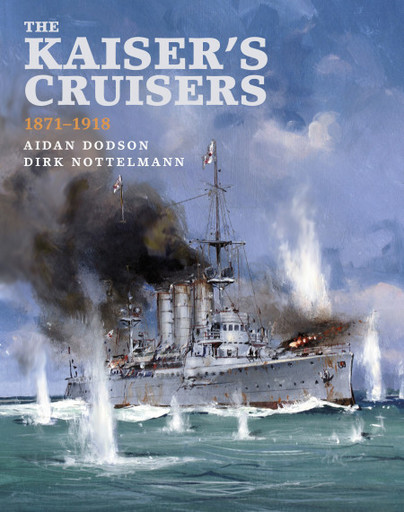
The Kaiser’s Cruisers 1871 – 1918. By Aiden Dodson and Dirk Nottelmann. Seaforth Publishing, Barnsley 2021.
Reviewed by John Mortimer
This book is a companion to “The Kaiser’s Battlefleet”, published by Aiden Dodson in 2016, and also to a series of articles published by Dirk Nottelmann in Warship International between 2011 and 2020. The book adopts a similar coverage, structure and approach to “The Kaiser’s Battlefleet”.
The coverage includes a diverse range of vessels classified as ‘small cruisers”. It extends from colonial gunboats through full-rigged, composite hulled, broadside-armed ships, to small, fleet scouts, and modern cruisers. The narrative covers strategic and political backgrounds to the classes of ship, their evolution and modifications, as well as their operational employment – both in peacetime and time of conflict. Ships of this category which were built for foreign governments are covered, including ships for China, Russia and Uruguay.
Extensive use has been made of United Kingdom, German and United States archives as well as secondary sources of information. Evidence of the growth and global employment of the German Navy is provided in Appendix 2 – Organisation of Capital Ships and Cruisers from 1884. For example it shows the East Asiatic Division/Squadron growing from three sailing or converted sailing ships Arcona, Thetis and Frauenlob in 1859 to 1861 through to two capital ships Scharnhorst and Gneisenau, two cruisers Nurnberg and Emden, and four smaller warships Iltis, Jaguar, Tiger and Luchs in 1914. It is worth noting that while British sources referred to Scharnhorst and Gneisenau as large cruisers in Germany they were classified as Capital Ships.
Rather than just presenting data on the ships, the authors provide detailed analysis of individual ships, ship classes, and their performance during trials, and operations, including conflict. The difficulties of procuring adequate fuel supplies and other logistics during the First World War had a major influence on the tactics and employment of cruisers on global trade interdiction operations.
The small cruisers were very active during the early stages of the First World War, but by the middle of 1915 they had been eliminated by the Royal Navy or interned in neutral territory to avoid capture. Nevertheless they did play a role in the sinking of four cruisers and numerous merchant ships. The Emden’s exploits in the Indian and Pacific Oceans was legendary, however, she encountered HMAS Sydney at the Cocos Islands and was destroyed. This small cruiser role of attacking global trade routes was subsequently assumed by German submarines and merchant raiders which continued to threaten shipping with considerable success.
Closer to Germany the small cruisers continued to make a significant contribution to naval operations, being present at most actions in the North Sea. Though they paid a significant cost with three lost at the First Battle of Heligoland Bight, four at Jutland with others lost to mines or torpedo attack.
In summing up the performance of small cruisers the following conclusion is reached:
“That the small cruisers did not fully meet the requirements of actual combat did not become clear until after the first battles of the First World War, resulting in a crash rearmament programme with the 15cm guns….But even this up-gunning was not sufficient, and before the end of the war a fundamental debate was under way that clearly pointed to the fallacy of ‘one size fits all’ concept for smaller cruising vessels.”
This book is valuable in many respects, but it stands out in the analysis of ship performance; the insights it provides on German Government and naval thinking at the time; and last but not least it is a quality book in English on a foreign warship type which is little covered in detail elsewhere. It is highly recommended.



